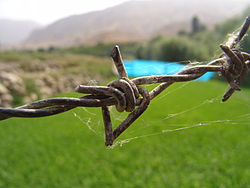With so many fencing choices out there, how are you supposed to decide which is the right one for your needs? Do you require a fence that prevents livestock from escaping, or are you simply in need of a perimeter fence to mark the boundaries of your property? This article will provide a brief overview of some different fence types, with information ranging from budget to form and function.
3-Rail or 4-Rail Pipe Fence
The benefits of a pipe fence include minimal upkeep, durable construction and reliable stability; however, some folks may consider the expense of a pipe fence to be too high, therefore making it impractical to implement. These steel rail ranch fences are ideal for keeping cattle and other adult livestock safe and secure within the confines of the enclosed space. Commonly, 3-rail and 4-rail pipe fences come in pre-fabricated sections, making installation quick and easy. They often come standard with a protective finish too, such as polyester powder or polyurethane, so there is no need to paint. This makes for an economical and worry-free product, with the power to withstand the elements and the long-lasting stability that you require.
Because of its “do-it-yourself” nature, barbed wire is an economical approach to large-scale fencing projects. You need only a few tools and, of course, your choice of wood or metal posts. Be sure to research common techniques and trouble shooting guides before deciding to take on the project yourself; there are many tips and tricks to be learned that will help prevent errors and save you time and money in the long run.
3, 4 or 5-Rail Wood Fence
Wood fences are known to offer the strength and effectiveness considered necessary in a fence, but the biggest downside is routine maintenance. Wood fences must be weather-proofed, painted and updated and replaced regularly, which adds to the cost and the hassle. If you decide to go with a wood rail fence, you can affix welded wire to the wood pieces to keep smaller animals in or out if desired.
Electric Wire Fence
If you need to protect your orchard, vineyard, garden or any other prized landscape, an electric wire fence may be exactly what you’ve been looking for. Most electric fences come standard with both high and low electric wires. This means all animals, large and small, will be prohibited from entering or exiting the property. One disadvantage to electric wire fencing is the amount of upkeep required. The wires often come loose, so routine maintenance is needed to ensure the success of this inexpensive and easy to install product.
Game-Proof Fence
Also known as a high fence or a deer-proof fence, game-proof fencing offers the height necessary to keep in what you need to keep in and keep out what you need to keep out. They often feature galvanized, painted steel and can be installed with automatic gate openers if necessary. Due to their size and scale, these are typically more expensive than many other fence types.
Wire Mesh Fence
Wire mesh is recommended for farmers and ranchers who need to keep horses and cattle of varying sizes contained. The advantage is the small openings in the wire mesh that prevent even small colts from getting their hooves stuck, thus preventing unnecessary injury in farm animals. They are durable, secure and keep livestock from climbing.
Cable Fence
Cable fencing offers the durability and strength of pipe fencing with the added bonus of saving a little money. Some of the benefits of cable fencing include easy installation, aesthetic appeal and minimal upkeep. So, consider the cost effective, safe, strong and secure cable fencing for those smaller fencing jobs.
Hopefully, the information presented above helped shed some light on different fencing types, including the advantages, disadvantages and overall practicality of the most common varieties. Once you decide on the proper fence type for your specific land requirements, you’ll need to consider the amount of site preparation needed before getting started with the installation.

